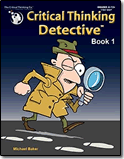Critical Thinking Detective™ Book 1
Fun Mystery Cases to Guide Decision-Making
Grades: 4-12+
Critical Thinking, Language Arts

Grades: 4-12+
Critical Thinking, Language Arts

- Multiple Award Winner
Description and Features
Description and Features
-
colorful way to stretch his brainThis was a nice, colorful way to stretch my son's brain and get him problem-solving and looking for details. I love the colorful illustrations and deep thinking that goes along with trying to deduce who is left over after eliminating some suspects.
Posted on
-
excellent for verbalizing thought processsStudents apply their critical thinking skills and logical reasoning to solve cases such as The Lunch Money Thief, The Necklace Thief, and The Football Thief. I read the puzzles aloud while they listened and studied the illustrations. I certainly could have given them each their own problems to solve, but I really enjoyed watching them discuss why they thought certain suspects were innocent and others were guilty. They pointed out details they noticed that defended their answers. Occasionally they argued over suspects. Solving the puzzles together required them to verbalize their thought process. After we finished working through a case, we would check the answer in the back of the book. I really liked that an explanation was given along with the answer. This was particularly helpful when we got a problem wrong. We were able to study the answer and see what clues we had overlooked. We really enjoyed working through the Critical Thinking Detective Book 1. One of the great things about this book is that it makes kids think without the structure of traditional core curriculum lessons.
Posted on
-
These mysteries help develop critical thinking skillsThese mysteries help develop your child’s critical thinking skills by requiring them to carefully read and analyze the information put before them. Once the student has digested the information by identifying and evaluating the evidence before them, they can then use their observation skills, deductive and inductive reasoning skills, along with reading comprehension skills to help in the decision-making process to solve the crime.
With the wide grade range, these mysteries are good for the old and young alike. As long as you are willing to read carefully and analyze the clues your student should be able to solve them. If not, you as the teacher/parent are able to give helpful hints.
Using this book with my 5th and 9th grade daughters was fun and easy to do. Each Friday I printed a copy of the two-page spread, double-sided for each of them. My older daughter would take the assignment with her to complete while on school beak at the gymnastics gym, while my younger daughter completed her mystery at home. Once both girls were home on Saturday morning we would go over the mystery and see how had solved the crime correctly. When one of them had the correct thief but the other one chose the wrong one, I had the child who solved it correctly explain why. If they both chose to the wrong thief, we would work through the mystery together to solve the crime. Solving the mysteries in this format worked best for our family.
If you are looking to add some critical thinking to your homeschool, look no further than the Critical Thinking Detective series.Posted on
-
N/AKids and adults quickly became hooked on the dozen fun, challenging yet satisfyingly solvable mysteries in Critical Thinking Detective. Most any reader willing to apply his or her powers of observation, deduction and inference can get to the bottom of these 12 entertaining whodunits. Each mystery involves a theft and provides the story, facts and a lineup of four suspects on a single page. The page that follows is broken into four lined sections in which the sleuth/reader is encouraged to use complete sentences to describe the best evidence supporting their conclusions regarding each suspect. Discerning which three suspects are innocent is often the shortest path to finding the guilty party. The process of sifting through facts for key evidence and then forming written conclusions gives students outstanding experience in exercising and developing those ever-essential critical thinking skills.
Posted on





 View Sample Pages
View Sample Pages 